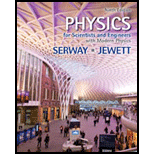
(a)
The maximum induced emf in the coil.
(a)
Answer to Problem 71AP
The maximum induced emf in the coil is
Explanation of Solution
Let
At
Write the expression for the emf induced in the coil.
Here,
Substitute
Write the expression for the area of the loop.
Here,
The maximum value of
Conclusion:
Substitute
Substitute
Therefore, the maximum induced emf in the coil is
(b)
The maximum rate of change of magnetic flux through coil.
(b)
Answer to Problem 71AP
The maximum rate of change of magnetic flux through coil is
Explanation of Solution
Write the expression for the rate of change of magnetic flux.
The minimum value of
Conclusion:
Substitute ,
Therefore, the maximum rate of change of magnetic flux through coil is
(c)
The emf induced at
(c)
Answer to Problem 71AP
The emf induced at
Explanation of Solution
At
Conclusion:
Substitute
Therefore, the emf induced at
(d)
The torque exerted on the coil by the magnetic field when the emf is maximum.
(d)
Answer to Problem 71AP
The torque exerted on the coil by the magnetic field when the emf is maximum is
Explanation of Solution
The emf induced is maximum when
Write the expression for the torque.
Here,
Conclusion:
Substitute
Therefore, the torque exerted on the coil by the magnetic field when the emf is maximum is
Want to see more full solutions like this?
Chapter 31 Solutions
Physics for Scientists and Engineers With Modern Physics
- A 5000-pF capacitor is charged to 100 V and then quickly connected to an 80-mH inductor. Determine (a) the maximum energy stored in the magnetic field of the inductor, (b) the peak value of the current, and (c) the frequency of oscillation of the circuit.arrow_forwardSuppose that a rectangular toroid has 2000 windings and a self-inductance of 0.040 H. If h = 0.10 m, what is the current flowing through a rectangular toroid when the energy in its magnetic field is 2.0 × 10-6 J?arrow_forwardDesign a current loop that, when rotated in a uniform magnetic field of strength 0.10 T, will produce an emf =0 sin t. where 0=110V and 0=110V .arrow_forward
- A flat, square coil of 20 turns that has sides of length 15.0 cm is rotating in a magnetic field of strength 0.050 T. If tlie maximum emf produced in die coil is 30.0 mV, what is the angular velocity of the coil?arrow_forwardA long solenoid of radius a with n turns per unit length is carrying a tune-dependent current I(t)=I0sintwhere I0 and are constants. The solenoid is surrounded by a wire of resistance R that has two circular loops of radius b with b>a. Find the magnitude and direction of current induced m the outer loops at tune t=0.arrow_forwardA conducting single-turn circular loop with a total resistance of 5.00 is placed in a time-varying magnetic field that produces a magnetic flux through the loop given by B = a + bt2 ct3, where a = 4.00 Wb, b = 11.0 Wb/s2, and c = 6.00 Wb/s3. B is in webers, and t is in seconds. What is the maximum current induced in the loop during the time interval t = 0 to t = 3.50 s?arrow_forward
- Suppose a 46 turn coil lies in the plane of the page in a uniform magnetic field that is directed into the page. The coil originally has an area of 0.175m^2. It is stretched to have no area in 0.100s. What is the magnitude (in V) and direction of the average induced emf if the uniform magnetic field has a strength of 1.90T?arrow_forwardA circular coil of radius 12.5 cm is located in a region of magnetic field where B(t) = (+0.3 T/s)t and with the magnetic field oriented perpendicular to the plane of the loop. Find the magnutide of the induced EMF in this loop at t = 10.0 s.arrow_forwardA magnetic field of 0.21 T exists in the region enclosed by a solenoid that has 239 turns and a diameter of 7.1 cm. Within what period of time must the field be reduced to zero if the average magnitude of the induced emf within the coil during this time interval is to be 5.58 kV? Answer in units of s.arrow_forward
 Physics for Scientists and Engineers, Technology ...PhysicsISBN:9781305116399Author:Raymond A. Serway, John W. JewettPublisher:Cengage Learning
Physics for Scientists and Engineers, Technology ...PhysicsISBN:9781305116399Author:Raymond A. Serway, John W. JewettPublisher:Cengage Learning Principles of Physics: A Calculus-Based TextPhysicsISBN:9781133104261Author:Raymond A. Serway, John W. JewettPublisher:Cengage Learning
Principles of Physics: A Calculus-Based TextPhysicsISBN:9781133104261Author:Raymond A. Serway, John W. JewettPublisher:Cengage Learning Physics for Scientists and Engineers: Foundations...PhysicsISBN:9781133939146Author:Katz, Debora M.Publisher:Cengage Learning
Physics for Scientists and Engineers: Foundations...PhysicsISBN:9781133939146Author:Katz, Debora M.Publisher:Cengage Learning
 Physics for Scientists and Engineers with Modern ...PhysicsISBN:9781337553292Author:Raymond A. Serway, John W. JewettPublisher:Cengage Learning
Physics for Scientists and Engineers with Modern ...PhysicsISBN:9781337553292Author:Raymond A. Serway, John W. JewettPublisher:Cengage Learning




